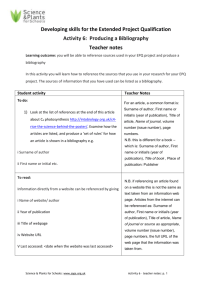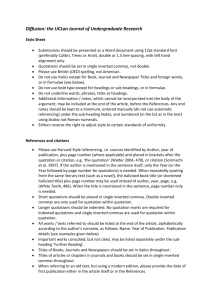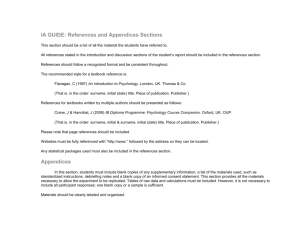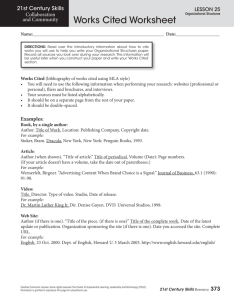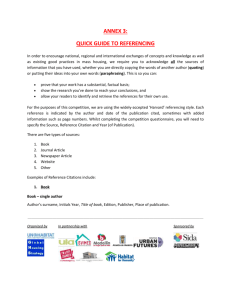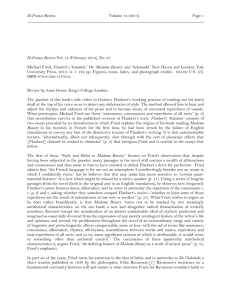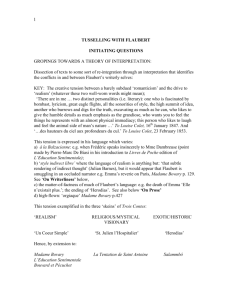GUIDELINES FOR AUTHORS Dix-Neuf publishes articles in both
advertisement
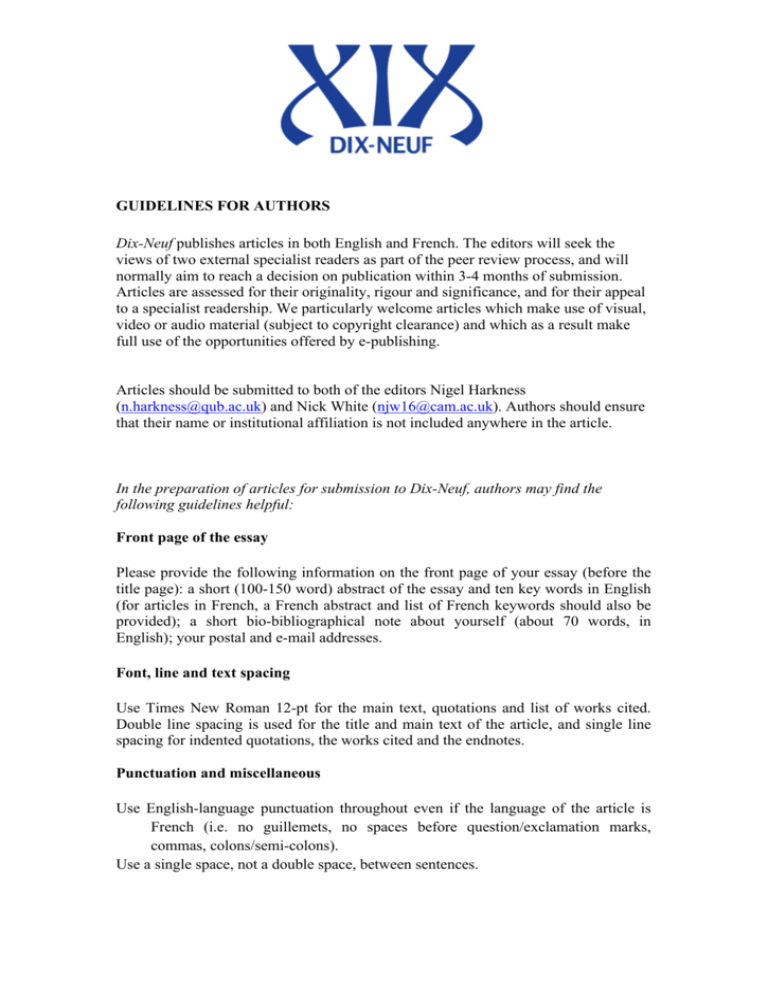
GUIDELINES FOR AUTHORS Dix-Neuf publishes articles in both English and French. The editors will seek the views of two external specialist readers as part of the peer review process, and will normally aim to reach a decision on publication within 3-4 months of submission. Articles are assessed for their originality, rigour and significance, and for their appeal to a specialist readership. We particularly welcome articles which make use of visual, video or audio material (subject to copyright clearance) and which as a result make full use of the opportunities offered by e-publishing. Articles should be submitted to both of the editors Nigel Harkness (n.harkness@qub.ac.uk) and Nick White (njw16@cam.ac.uk). Authors should ensure that their name or institutional affiliation is not included anywhere in the article. In the preparation of articles for submission to Dix-Neuf, authors may find the following guidelines helpful: Front page of the essay Please provide the following information on the front page of your essay (before the title page): a short (100-150 word) abstract of the essay and ten key words in English (for articles in French, a French abstract and list of French keywords should also be provided); a short bio-bibliographical note about yourself (about 70 words, in English); your postal and e-mail addresses. Font, line and text spacing Use Times New Roman 12-pt for the main text, quotations and list of works cited. Double line spacing is used for the title and main text of the article, and single line spacing for indented quotations, the works cited and the endnotes. Punctuation and miscellaneous Use English-language punctuation throughout even if the language of the article is French (i.e. no guillemets, no spaces before question/exclamation marks, commas, colons/semi-colons). Use a single space, not a double space, between sentences. By default, single inverted commas should be used in your article unless used inside existing inverted commas. Avoid op. cit., loc. cit., art. cit. and ibid. (see referencing conventions below) Dates should be given in the form 2 August 2010. Decades should be referred to without apostrophe as the 1790s, the 1800s. Use accents on upper case, but always omit the grave accent on upper-case Italicize the titles of books, plays, and periodicals; short stories and poems are to be put in quotation marks. In French titles it is normally only the initial letters of the first word and of proper nouns that are capitalized. But if the first word is a definite article, the following noun and any preceding adjectives also take an initial capital: Le Médecin malgré lui; Les Grands Cimetières sous la lune; Un début dans la vie; Une ténébreuse affaire; Du latin aux langues romanes; Nouveau cours de grammaire; Histoire de la littérature française; A la recherche du temps perdu; Revue des deux mondes etc. However, for reasons of symmetry, capitals are sometimes used elsewhere: ‘Le Corbeau et le Renard’; Le Rouge et le Noir. Use Arabic, not Roman numerals throughout. Use en-dashes (–) with a space before and after it, not em-dashes (—) with no spaces on either side of it. Use ‘-ize/-ization’ rather than ‘-ise/-isation’. But: arise, comprise, compromise, despise, exercise, revise, surmise, surprise, improvise, summarise, paralyse, analyse. For possessive forms of words that end with an ‘s’, add a further ‘s’ : Hérodias’s, Cléophas’s etc. For common French terms, use italics: aubergiste, mise en scène, Ancien Régime Use the form ‘chapter 5’ rather than ‘Chapter Five’/’Chapter V’ etc. Place footnote numerals after punctuation marks. References and quotations Dix-Neuf follows the author-date system. Endnotes (not footnotes) are used for substantive comment only. A Bibliography at the end of the article is used for all items quoted, with abbreviated references to these items in brackets in your text. References in the text follow the form (Gothot-Mersch, 1962: 235), (Finch, 2004: 148-50) etc. where the reference is to a single article or book listed in the Bibliography. If you have given the author’s name within the sentence itself (eg. ‘As Finch argues:.....’) then do not repeat it in the parenthetical reference. For references to multi-volume items, the volume number precedes the pages or page span (Baudelaire, 1975, II: 227). For references to complete works which you refer to throughout the article, it is desirable to use an abbreviation for subsequent references (eg. OC for Œuvres complètes) include the statement (hereafter OC) after the first reference; subsequent references will be in the form (OC, II: 227). Works Cited Place the list of works cited at the end of the article on a fresh page before the endnotes. Use the title Bibliography in 12-pt bold, with a double return before the first entry. A sample Works Cited is given at the end of this style guide. Use a hanging indent in the Works Cited. Please note the order and style (including punctuation) of items, as follows: • Books Surname, first name. Year of publication. Title of book. Place of publication: publisher. • Articles Surname, first name. Year of publication. Title of article without inverted commas. Title of journal, number (issue): page span (no pp.). • Book chapters Surname, first name. Year of publication. Title of chapter without inverted commas. In: Name of editor, ed (or eds). Title of book or collection.. Place of publication: publisher, page numbers (preceded by pp.). • Editions Surname, first name. Year of publication. Title of work. Ed. name of editor(s). Number of vols. Place of publication: publisher. (Note that, in all cases where there is more than one author, only the first author’s first name and surname are inverted.) Works Cited (sample) Brown, Andrew. 2009. Brief Lives: Gustave Flaubert. London: Hesperus Press. Donaldson-Evans, Mary. 2009. ‘Madame Bovary’ at the Movies: Adaption, Ideology, Context. Amsterdam: Rodopi. Dufour, Philippe, ed. 2009. Flaubert. Revue critique et génétique 2: Flaubert lecteur [online] [accessed 21 August 2010]. Available at: <http://flaubert.revues.org/> Flaubert, Gustave. 1964. Œuvres complètes. Ed. Bernard Masson. 2 vols. Paris: Seuil. Flaubert, Gustave. 2001a. Œuvres de jeunesse. Ed. Claudine Gothot-Mersch and Guy Sagnes. Paris: Gallimard- Pléiade. Flaubert, Gustave. 2001b. Mémoires d’un fou – Memoirs of a Madman. Parallel translation and critical edition by Timothy Unwin. Liverpool: Liverpool Online Series. Olds, Marshall C. 1997. Value and Social Mobility in Flaubert. In: Barbara T. Cooper and Mary Donaldson-Evans, eds. Moving Forward, Holding Fast: The Dynamics of Nineteenth-Century French Culture. Amsterdam: Rodopi, pp. 81-90. Orr, Mary. 2005. Still Life and Moving Death in Flaubert’s L’Éducation sentimentale. Dix-Neuf, 5: 16-27. Rees, Kate. 2010. Flaubert: Transportation, Progression, Progress. Bern: Peter Lang. The editors gratefully acknowledge the help of Tim Unwin, Anne Green and Mary Orr in the compilation of this Style Guide.
